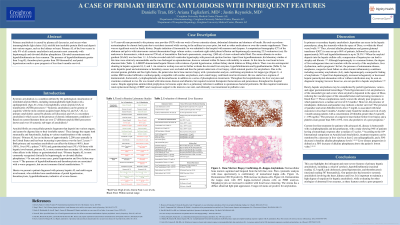Tuesday Poster Session
Category: Liver
P4806 - A Case of Primary Hepatic Amyloidosis With Infrequent Features
Tuesday, October 29, 2024
10:30 AM - 4:00 PM ET
Location: Exhibit Hall E

Has Audio

Ariana R. Tagliaferri, MD
Creighton University Medical Center
Phoenix, AZ
Presenting Author(s)
Danielle Tran, BS1, Ariana R. Tagliaferri, MD2, Justin Reynolds, MD2
1Creighton University School of Medicine, Omaha, NE; 2Creighton University Medical Center, Phoenix, AZ
Introduction: Primary amyloidosis is caused by plasma cell dyscrasias, and occurs when immunoglobulin light chains (AL) misfold into insoluble protein fibrils and deposit into various organs, such as the kidneys or heart. Primary AL of the liver occurs in only 9% of all systemic amyloidosis and presents most commonly with hepatomegaly and elevated alkaline phosphatase. Elevated transaminases and hyperbilirubinemia are less common. The presence of hyperbilirubinemia greater than 5 mg/dL, thrombocytosis greater than 500 thousand/uL and portal hypertension confer a poor prognosis of less than 6 months survival.
Case Description/Methods: A 47 year-old man presented with abdominal distention, dyspnea and peripheral edema. A right-sided pleural effusion and ascites were identified for which he had a thoracentesis (transudative) and paracentesis (SAAG < 1.1). His admission labs were significant for elevated liver enzymes (AST 109 units/L; ALT 55 units/L; ALP 1681 units/L), hyperbilirubinemia (6.9 mg/dL), an AKI (Cr 1.35 mg/dL) and thrombocytosis (533 thousand/uL). A CT showed hepatomegaly of 22.5 cm without evidence of fibrosis or portal hypertension and a MRCP did not reveal ductal abnormalities. A viral hepatitis and autoimmune disease workup was negative. Despite diuresis, his renal and liver function worsened. Due to profound hypoalbuminemia (1 g,/dL), free light chains and gamma globulins were obtained and elevated. A liver biopsy revealed AL-kappa amyloidosis. A cardiac MRI revealed infiltrative cardiomyopathy, and a renal and bone marrow biopsy confirmed further organ infiltration. He was treated with daratumumab, bortezomib, cyclophosphamide and dexamethasone in addition to plasmapheresis. His hospitalization was complicated by sepsis secondary to pneumonia and SBP, and he required CRRT and vasopressor support. He improved and was discharged to a rehab to continue on permanent dialysis and chemotherapy.
Discussion: This case highlights the infrequent and more severe features of primary hepatic amyloidosis, including a a triad of cytolysis, hyperbilirubinemia (maximal reading 12.3 mg/dL) and cholestasis, portal hypertension, and thrombocytosis (maximal reading 567 thousand/uL). Our patient also had extensive systemic amyloidosis involving the heart, kidneys and liver. It is important to maintain a high degree of suspicion for hepatic amyloidosis, while evaluating for other etiologies of abnormal liver enzymes, as these features confer a poor prognosis.
Disclosures:
Danielle Tran, BS1, Ariana R. Tagliaferri, MD2, Justin Reynolds, MD2. P4806 - A Case of Primary Hepatic Amyloidosis With Infrequent Features, ACG 2024 Annual Scientific Meeting Abstracts. Philadelphia, PA: American College of Gastroenterology.
1Creighton University School of Medicine, Omaha, NE; 2Creighton University Medical Center, Phoenix, AZ
Introduction: Primary amyloidosis is caused by plasma cell dyscrasias, and occurs when immunoglobulin light chains (AL) misfold into insoluble protein fibrils and deposit into various organs, such as the kidneys or heart. Primary AL of the liver occurs in only 9% of all systemic amyloidosis and presents most commonly with hepatomegaly and elevated alkaline phosphatase. Elevated transaminases and hyperbilirubinemia are less common. The presence of hyperbilirubinemia greater than 5 mg/dL, thrombocytosis greater than 500 thousand/uL and portal hypertension confer a poor prognosis of less than 6 months survival.
Case Description/Methods: A 47 year-old man presented with abdominal distention, dyspnea and peripheral edema. A right-sided pleural effusion and ascites were identified for which he had a thoracentesis (transudative) and paracentesis (SAAG < 1.1). His admission labs were significant for elevated liver enzymes (AST 109 units/L; ALT 55 units/L; ALP 1681 units/L), hyperbilirubinemia (6.9 mg/dL), an AKI (Cr 1.35 mg/dL) and thrombocytosis (533 thousand/uL). A CT showed hepatomegaly of 22.5 cm without evidence of fibrosis or portal hypertension and a MRCP did not reveal ductal abnormalities. A viral hepatitis and autoimmune disease workup was negative. Despite diuresis, his renal and liver function worsened. Due to profound hypoalbuminemia (1 g,/dL), free light chains and gamma globulins were obtained and elevated. A liver biopsy revealed AL-kappa amyloidosis. A cardiac MRI revealed infiltrative cardiomyopathy, and a renal and bone marrow biopsy confirmed further organ infiltration. He was treated with daratumumab, bortezomib, cyclophosphamide and dexamethasone in addition to plasmapheresis. His hospitalization was complicated by sepsis secondary to pneumonia and SBP, and he required CRRT and vasopressor support. He improved and was discharged to a rehab to continue on permanent dialysis and chemotherapy.
Discussion: This case highlights the infrequent and more severe features of primary hepatic amyloidosis, including a a triad of cytolysis, hyperbilirubinemia (maximal reading 12.3 mg/dL) and cholestasis, portal hypertension, and thrombocytosis (maximal reading 567 thousand/uL). Our patient also had extensive systemic amyloidosis involving the heart, kidneys and liver. It is important to maintain a high degree of suspicion for hepatic amyloidosis, while evaluating for other etiologies of abnormal liver enzymes, as these features confer a poor prognosis.
Disclosures:
Danielle Tran indicated no relevant financial relationships.
Ariana Tagliaferri indicated no relevant financial relationships.
Justin Reynolds indicated no relevant financial relationships.
Danielle Tran, BS1, Ariana R. Tagliaferri, MD2, Justin Reynolds, MD2. P4806 - A Case of Primary Hepatic Amyloidosis With Infrequent Features, ACG 2024 Annual Scientific Meeting Abstracts. Philadelphia, PA: American College of Gastroenterology.
